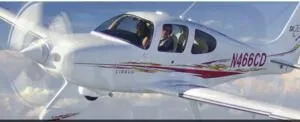
How do I become a pilot?
Learning to fly involves not only the time in the air with an instructor, but also time spent studying subjects such as how the airplane flies, weather, radio communications, and airport operations, to name some. As you progress in your study, you’ll apply what you’ve learned to flying the plane, and gain real-world experience which will make sense of it all. It’s not that difficult! You don’t have to be great with math or possess great skills – most people, from all walks of life, can master this skill. My job is to bring it to you in parts that can be mastered, one by one, until you have the confidence and experience to do it well.
“The Federal Aviation Administration (FAA), lays out several requirements to become a licensed pilot, but basically these are:
- 40 hours of flight time for a Private license (which allows you to take passengers without restrictions), 20 of which will be with an instructor. Some of this time will be spent learning to navigate to other airports (“cross-country”), both during the day and at night. Some time will be spent flying by reference to instruments, also. During your training, after you have attained the skills necessary to pilot an airplane on your own (“solo”), you’ll conduct flights to different airports, at least on of which will be at least 150 miles long. At the completion of training you will be prepared for the “checkride,” or the flight test with an examiner, who will check to ensure that you have learned the skills to be a proficient and safe pilot.
- There is a knowledge requirement, also. Subjects such as aircraft performance, weather, use of aeronautical charts, radio communications, and airport operations, among others, will be covered. The FAA allows several different ways to do this, such as home study, which can include online courses, and there are organized ground schools conducted at various locations for those who do better in a classroom environment. Later, when you have a good understanding of these subjects, you’ll take a multiple-choice “written test”, normally conducted via computer at a testing site. Once you have passed the written, and at the completion of flight training, you will be ready to take the flight test.
- You will obtain a medical certificate from an FAA-approved medical examiner, which shows that you are in basically good health. It’s not very stringent, and most people will have no problems obtaining the 3rd class medical required. By the way, you don’t have to have perfect vision! Corrected or uncorrected vision of 20/40 is all that’s required. For anyone who may be concerned about their ability to get a medical, there is also another way to get a license, using the Sport Pilot rule, which basically says that if you are able to hold a driver’s license then you can fly, although with a few restrictions that the Private Pilot doesn’t have. Please contact me for more information!
Although the required minimum flight time is 40 hours, most students will take more time than that. Nationally, the average has been somewhere around 70 hours. However, this is understandable in light of the sometimes complex and varied environment we operate in. Today’s aircraft can also be more complicated, with recent advances in “avionics” (the displays and communications equipment on board) and other aircraft systems. There are truly wonderful “glass cockpit” displays coming out every day, which have revolutionized the aviation world, and brought capability to small airplanes that wasn’t even imagined 10 years ago. However, the skills to pilot these planes are still based on a good foundation of training that I teach. Before all this great technology can be effective, the aspiring pilot needs to really be a master of the airplane, and this is where I spend most of my time. I will teach you to fly the airplane in a way that emphasizes strong stick-and-rudder technique, in other words really being able to sense the airplane and fly accurately. I bring 7000 hours of experience to this task, and I can help make you an exceptional pilot who will be more than prepared to fly with confidence. Personally, I appreciate the value of learning to fly in a simple airplane that has only a few instruments, which allows the student to concentrate on the basics. As your skill level progresses, you’ll be able to handle the more complex airplanes with relative ease.

